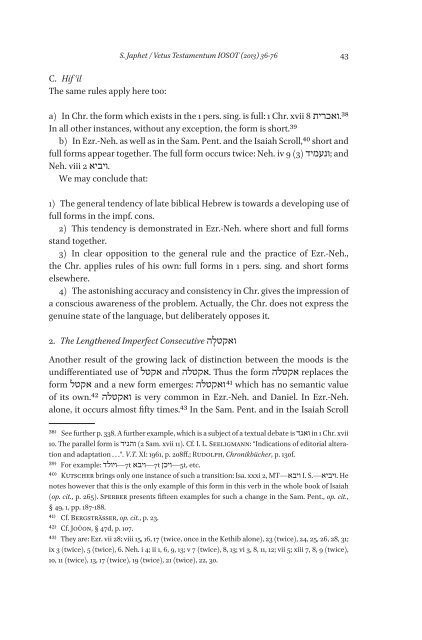Special Issue IOSOT 2013 - Books and Journals
Special Issue IOSOT 2013 - Books and Journals
Special Issue IOSOT 2013 - Books and Journals
You also want an ePaper? Increase the reach of your titles
YUMPU automatically turns print PDFs into web optimized ePapers that Google loves.
C. Hif ʿil<br />
The same rules apply here too:<br />
S. Japhet / Vetus Testamentum <strong>IOSOT</strong> (<strong>2013</strong>) 36-76 43<br />
38.ואכרית а) In Chr. the form which exists in the 1 pers. sing. is full: 1 Chr. xvii 8<br />
In all other instances, without any exception, the form is short.39<br />
b) In Ezr.-Neh. as well as in the Sam. Pent. <strong>and</strong> the Isaiah Scroll,40 short <strong>and</strong><br />
full forms appear together. The full form occurs twice: Neh. iv 9 (3) ;ונעמיד <strong>and</strong><br />
.ויביא Neh. viii 2<br />
We may conclude that:<br />
1) The general tendency of late biblical Hebrew is towards a developing use of<br />
full forms in the impf. cons.<br />
2) This tendency is demonstrated in Ezr.-Neh. where short <strong>and</strong> full forms<br />
st<strong>and</strong> together.<br />
3) In clear opposition to the general rule <strong>and</strong> the practice of Ezr.-Neh.,<br />
the Chr. applies rules of his own: full forms in 1 pers. sing. <strong>and</strong> short forms<br />
elsewhere.<br />
4) The astonishing accuracy <strong>and</strong> consistency in Chr. gives the impression of<br />
a conscious awareness of the problem. Actually, the Chr. does not express the<br />
genuine state of the language, but deliberately opposes it.<br />
ואקטלָ ה 2. The Lengthened Imperfect Consecutive<br />
Another result of the growing lack of distinction between the moods is the<br />
undifferentiated use of אקטל <strong>and</strong> .אקטלה Thus the form אקטלה replaces the<br />
form אקטל <strong>and</strong> a new form emerges: ואקטלה 41 which has no semantic value<br />
of its ואקטלה own.42 is very common in Ezr.-Neh. <strong>and</strong> Daniel. In Ezr.-Neh.<br />
alone, it occurs almost fifty times.43 In the Sam. Pent. <strong>and</strong> in the Isaiah Scroll<br />
38) See further p. 338. A further example, which is a subject of a textual debate is ואגד in 1 Chr. xvii<br />
10. The parallel form is והגיד )2 Sam. xvii 11). Cf. I. L. Seeligmann: “Indications of editorial alteration<br />
<strong>and</strong> adaptation . . .”. V.T. XI: 1961, p. 208ff.; Rudolph, Chronikbücher, p. 130f.<br />
39) For example: 7t—ויולד 7t—ויבא ,5t—ויכן etc.<br />
40) Kutscher brings only one instance of such a transition: Isa. xxxi 2, ויבא—MT I. .ויביא—.S He<br />
notes however that this is the only example of this form in this verb in the whole book of Isaiah<br />
(op. cit., p. 265). Sperber presents fifteen examples for such a change in the Sam. Pent., op. cit.,<br />
§ 49, 1, pp. 187-188.<br />
41) Cf. Bergsträsser, op. cit., p. 23.<br />
42) Cf. Joüon, § 47d, p. 107.<br />
43) They are: Ezr. vii 28; viii 15, 16, 17 (twice, once in the Kethib alone), 23 (twice), 24, 25, 26, 28, 31;<br />
ix 3 (twice), 5 (twice), 6. Neh. i 4; ii 1, 6, 9, 13; v 7 (twice), 8, 13; vi 3, 8, 11, 12; vii 5; xiii 7, 8, 9 (twice),<br />
10, 11 (twice), 13, 17 (twice), 19 (twice), 21 (twice), 22, 30.








![Am HaSefer [Volk des Buches] - Books and Journals](https://img.yumpu.com/20648352/1/174x260/am-hasefer-volk-des-buches-books-and-journals.jpg?quality=85)







